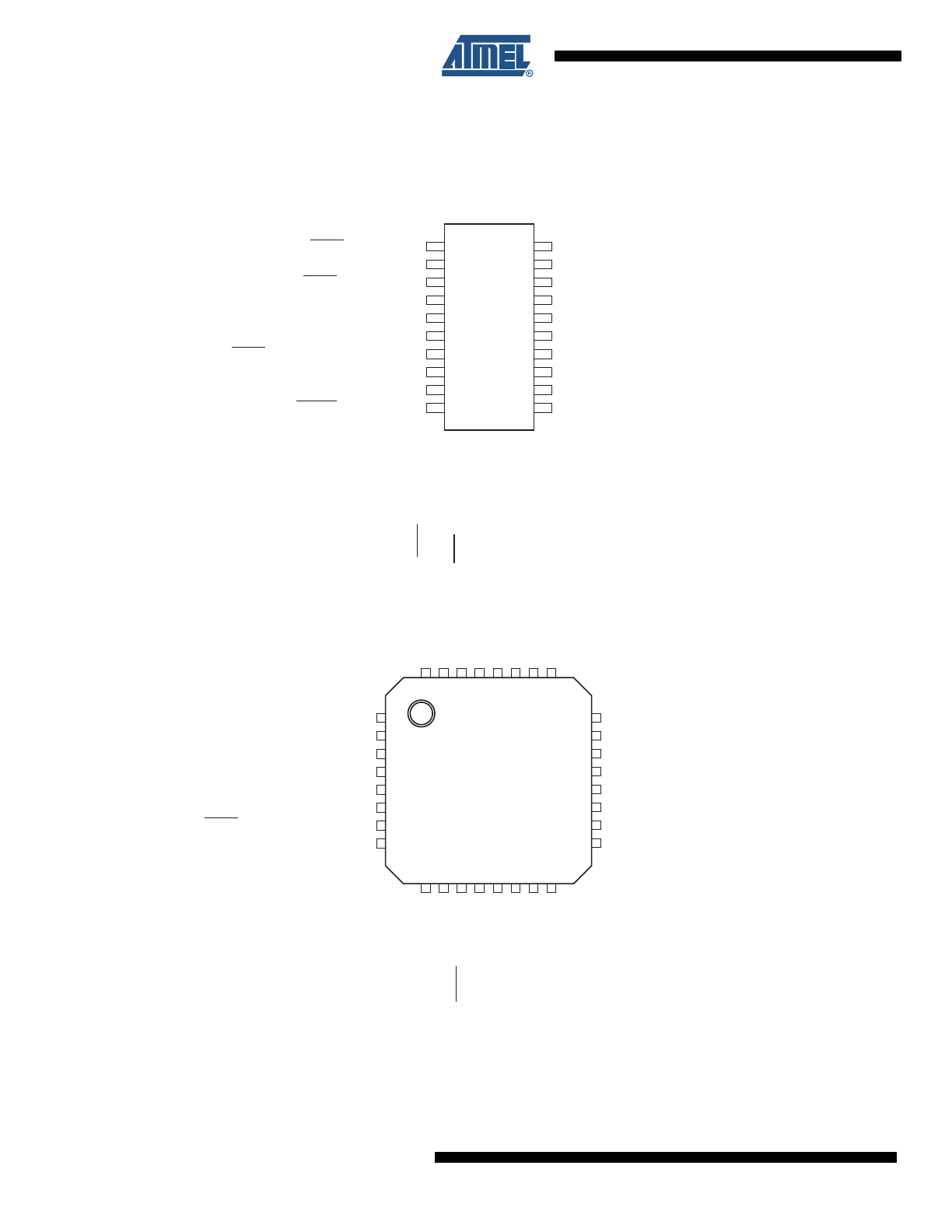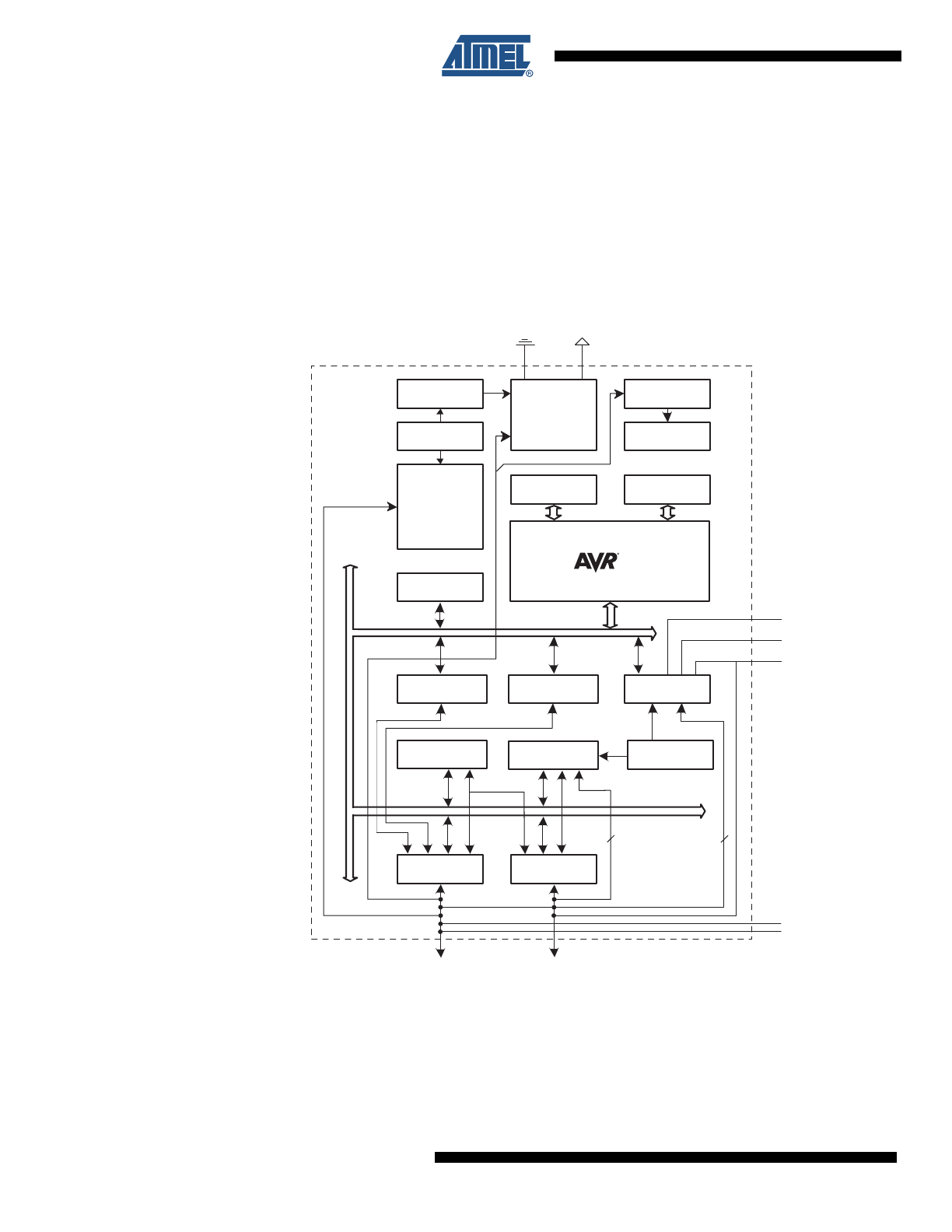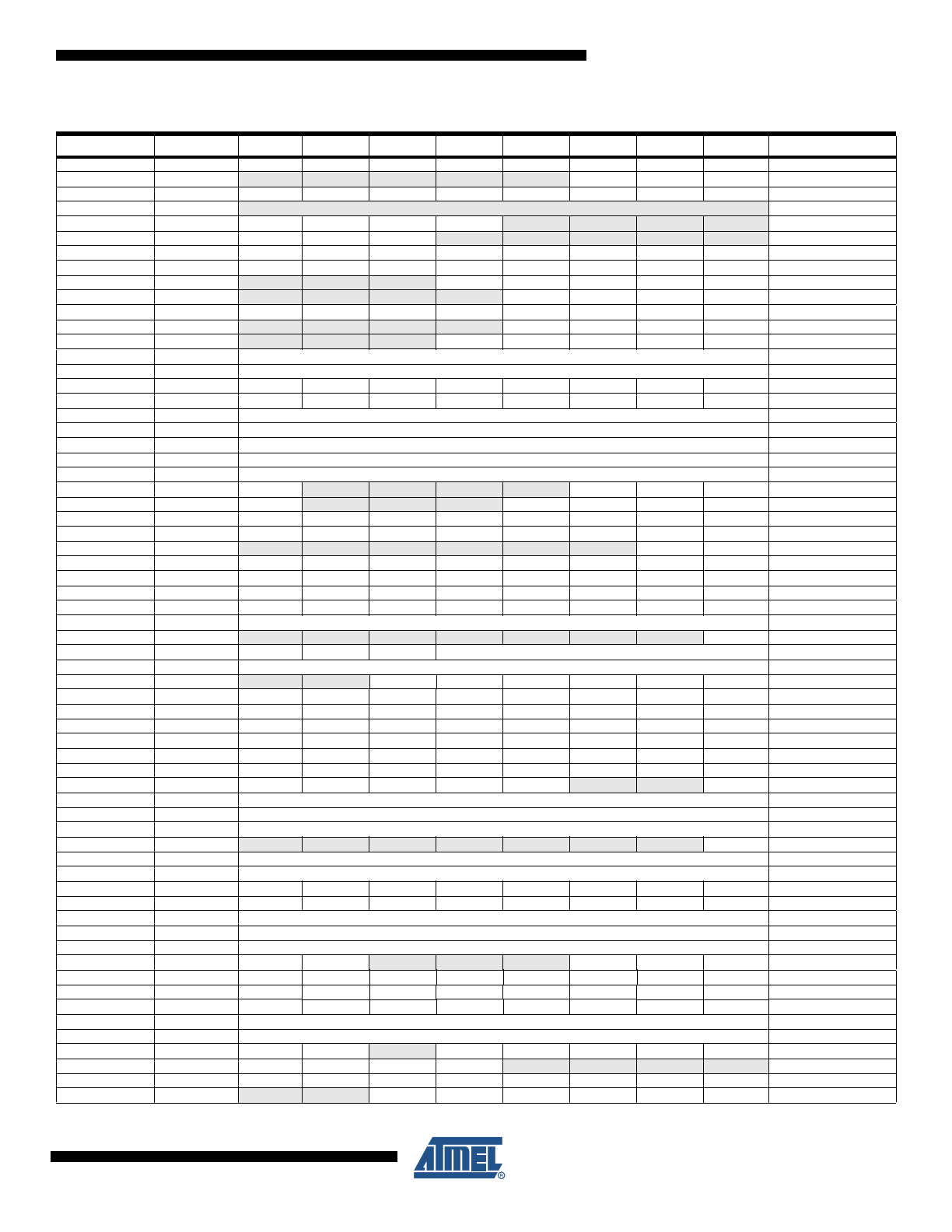
Features
•
High Performance, Low Power AVR
®
8-Bit Microcontroller
•
Advanced RISC Architecture
– 123 Powerful Instructions – Most Single Clock Cycle Execution
– 32 x 8 General Purpose Working Registers
– Fully Static Operation
– Up to 20 MIPS Throughput at 20 MHz
•
High Endurance Non-volatile Memory Segments
– 2/4/8K Bytes of In-System Self-Programmable Flash Program Memory
• Endurance: 10,000 Write/Erase Cycles
– 128/256/512 Bytes of In-System Programmable EEPROM
• Endurance: 100,000 Write/Erase Cycles
– 128/256/512 Bytes of Internal SRAM
– Data retention: 20 Years at 85°C / 100 Years at 25
°
C
– In-System Programmable via SPI Port
– Programming Lock for Software Security
•
Peripheral Features
– One 8/16-bit Timer/Counter with Prescaler
– One 8/10-bit High Speed Timer/Counter with Prescaler
• 3 High Frequency PWM Outputs with Separate Output Compare Registers
• Programmable Dead Time Generator
– 10-bit ADC
• 11 Single-Ended Channels
• 16 Differential ADC Channel Pairs
• 15 Differential ADC Channel Pairs with Programmable Gain (1x, 8x, 20x, 32x)
– On-Chip Analog Comparator
– Programmable Watchdog Timer with Separate On-Chip Oscillator
– Universal Serial Interface with Start Condition Detector
– Interrupt and Wake-up on Pin Change
•
Special Microcontroller Features
– debugWIRE On-Chip Debug System
– Power-on Reset and Programmable Brown-out Detection
– Internal Calibrated Oscillator
– External and Internal Interrupt Sources
– Four Sleep Modes: Low Power Idle, ADC Noise Reduction, Standby and Power-
Down
– On-Chip Temperature Sensor
•
I/O and Packages
– 16 Programmable I/O Lines
– 20-pin PDIP, 20-pin SOIC, 20-pin TSSOP and 32-pad MLF
•
Operating Voltage
– 1.8 – 5.5V
•
Speed Grades
– 0 – 4 MHz @ 1.8 – 5.5V
– 0 – 10 MHz @ 2.7 – 5.5V
– 0 – 20 MHz @ 4.5 – 5.5V
•
Power Consumption at 1 MHz, 1.8V, 25°C
– Active: 200 µA
– Power-Down Mode: 0.1 µA
8-bit
Microcontroller
with 2/4/8K
Bytes In-System
Programmable
Flash
ATtiny261A
ATtiny461A
ATtiny861A
Summary
8197CS–AVR–05/11

2
8197CS–AVR–05/11
ATtiny261A/461A/861A
1.
Pin Configurations
Figure 1-1.
Pinout ATtiny261A/461A/861A
Note:
To ensure mechanical stability the center pad underneath the QFN/MLF package should be soldered to ground on the board.
1
2
3
4
5
6
7
8
9
10
20
19
18
17
16
15
14
13
12
11
(MOSI/DI/SDA/OC1A/PCINT8) PB0
(MISO/DO/OC1A/PCINT9) PB1
(SCK/USCK/SCL/OC1B/PCINT10) PB2
(OC1B/PCINT11) PB3
VCC
GND
(ADC7/OC1D/CLKI/XTAL1/PCINT12) PB4
(ADC8/OC1D/CLKO/XTAL2/PCINT13) PB5
(ADC9/INT0/T0/PCINT14) PB6
(ADC10/RESET/PCINT15) PB7
PA0 (ADC0/DI/SDA/PCINT0)
PA1 (ADC1/DO/PCINT1)
PA2 (ADC2/INT1/USCK/SCL/PCINT2)
PA3 (AREF/PCINT3)
AGND
AVCC
PA4 (ADC3/ICP0/PCINT4)
PA5 (ADC4/AIN2/PCINT5)
PA6 (ADC5/AIN0/PCINT6)
PA7 (ADC6/AIN1/PCINT7)
PDIP/SOIC/TSSOP
1
2
3
4
5
6
7
8
24
23
22
21
20
19
18
17
32
31
30
29
28
27
26
25
9
10
11
12
13
14
15
16
NC
(OC1B/PCINT11) PB3
NC
VCC
GND
NC
(ADC7/OC1D/CLKI/XTAL1/PCINT12) PB4
(ADC8/OC1D/CLKO/XTAL2/PCINT13) PB5
NC
PA2 (ADC2/INT1/USCK/SCL/PCINT2)
PA3 (AREF/PCINT3)
AGND
NC
NC
AVCC
PA4 (ADC3/ICP0/PCINT4)
NC
(ADC9/INT0/T0/PCINT14) PB6
(ADC10/RESE
T/PCINT15) PB7
NC
(ADC6/AIN1/PCINT7) P
A
7
(
ADC5/AIN0/PCINT6) P
A
6
(ADC4/AIN2/PCINT5) P
A
5
NC
PB2 (SCK/USCK/SCL/OC1B/PCINT10)
PB1 (MISO/DO/OC1A/PCINT9)
PB0 (MOSI/DI/SD
A/OC1A/PCINT8)
NC
NC
NC
PA0 (
ADC0/DI/SD
A/PCINT0)
PA1 (
ADC1/DO/PCINT1)
QFN/MLF

3
8197CS–AVR–05/11
ATtiny261A/461A/861A
1.1
Pin Descriptions
1.1.1
VCC
Supply voltage.
1.1.2
GND
Ground.
1.1.3
AVCC
Analog supply voltage. This is the supply voltage pin for the Analog-to-digital Converter (ADC),
the analog comparator, the Brown-Out Detector (BOD), the internal voltage reference and Port
A. It should be externally connected to VCC, even if some peripherals such as the ADC are not
used. If the ADC is used AVCC should be connected to VCC through a low-pass filter.
1.1.4
AGND
Analog ground.
1.1.5
Port A (PA7:PA0)
An 8-bit, bi-directional I/O port with internal pull-up resistors, individually selectable for each bit.
Output buffers have symmetrical drive characteristics with both high sink and source capability.
As inputs, port pins that are externally pulled low will source current if pull-up resistors have
been activated. Port pins are tri-stated when a reset condition becomes active, even if the clock
is not running.
Port A also serves the functions of various special features of the device, as listed on
page 62
.
1.1.6
Port B (PB7:PB0)
An 8-bit, bi-directional I/O port with internal pull-up resistors, individually selectable for each bit.
Output buffers have symmetrical drive characteristics with both high sink and source capability.
As inputs, port pins that are externally pulled low will source current if pull-up resistors have
been activated. Port pins are tri-stated when a reset condition becomes active, even if the clock
is not running.
Port B also serves the functions of various special features of the device, as listed on
page 65
.
1.1.7
RESET
Reset input. A low level on this pin for longer than the minimum pulse length will generate a
reset, even if the clock is not running and provided the reset pin has not been disabled. The min-
imum pulse length is given in
Table 19-4 on page 188
. Shorter pulses are not guaranteed to
generate a reset.
The reset pin can also be used as a (weak) I/O pin.

4
8197CS–AVR–05/11
ATtiny261A/461A/861A
2.
Overview
ATtiny261A/461A/861A are low-power CMOS 8-bit microcontrollers based on the AVR
enhanced RISC architecture. By executing powerful instructions in a single clock cycle, the
devices achieve throughputs approaching 1 MIPS per MHz allowing the system designer to opti-
mize power consumption versus processing speed.
2.1
Block Diagram
Figure 2-1.
Block Diagram
The AVR core combines a rich instruction set with 32 general purpose working registers. All 32
registers are directly connected to the Arithmetic Logic Unit (ALU), allowing two independent
registers to be accessed in one single instruction executed in one clock cycle. The resulting
architecture is more code efficient while achieving throughputs up to ten times faster than con-
ventional CISC microcontrollers.
PORT A (8)
PORT B (8)
USI
Timer/Counter1
Timer/Counter0
A/D Conv.
Internal
Bandgap
Analog Comp.
SRAM
Flash
EEPROM
Watchdog
Oscillator
Watchdog
Timer
Oscillator
Circuits /
Clock
Generation
Power
Supervision
POR / BOD &
RESET
VC
C
GND
PROGRAM
LOGIC
debugWIRE
AGND
AREF
AVCC
D
A
TABUS
PA[0:7]
PB[0:7]
11
RESET
XTAL[1:2]
CPU
3

5
8197CS–AVR–05/11
ATtiny261A/461A/861A
The ATtiny261A/461A/861A provides the following features: 2/4/8K byte of In-System Program-
mable Flash, 128/256/512 bytes EEPROM, 128/256/512 bytes SRAM, 16 general purpose I/O
lines, 32 general purpose working registers, an 8-bit Timer/Counter with compare modes, an 8-
bit high speed Timer/Counter, a Universal Serial Interface, Internal and External Interrupts, an
11-channel, 10-bit ADC, a programmable Watchdog Timer with internal oscillator, and four soft-
ware selectable power saving modes. Idle mode stops the CPU while allowing the SRAM,
Timer/Counter, ADC, Analog Comparator, and Interrupt system to continue functioning. Power-
down mode saves the register contents, disabling all chip functions until the next Interrupt or
Hardware Reset. ADC Noise Reduction mode stops the CPU and all I/O modules except ADC,
to minimize switching noise during ADC conversions. In Standby mode, the crystal/resonator
oscillator is running while the rest of the device is sleeping, allowing very fast start-up combined
with low power consumption.
The device is manufactured using Atmel’s high density non-volatile memory technology. The
On-chip ISP Flash allows the Program memory to be re-programmed In-System through an SPI
serial interface, by a conventional non-volatile memory programmer or by an On-chip boot code
running on the AVR core.
The ATtiny261A/461A/861A AVR is supported by a full suite of program and system develop-
ment tools including: C Compilers, Macro Assemblers, Program Debugger/Simulators, and
Evaluation kits.

6
8197CS–AVR–05/11
ATtiny261A/461A/861A
3.
General Information
3.1
Resources
A comprehensive set of drivers, application notes, data sheets and descriptions on development
tools are available for download at http://www.atmel.com/avr.
3.2
Code Examples
This documentation contains simple code examples that briefly show how to use various parts of
the device. These code examples assume that the part specific header file is included before
compilation. Be aware that not all C compiler vendors include bit definitions in the header files
and interrupt handling in C is compiler dependent. Please confirm with the C compiler documen-
tation for more details.
For I/O Registers located in the extended I/O map, “IN”, “OUT”, “SBIS”, “SBIC”, “CBI”, and “SBI”
instructions must be replaced with instructions that allow access to extended I/O. Typically, this
means “LDS” and “STS” combined with “SBRS”, “SBRC”, “SBR”, and “CBR”. Note that not all
AVR devices include an extended I/O map.
3.3
Capacitive Touch Sensing
Atmel QTouch Library provides a simple to use solution for touch sensitive interfaces on Atmel
AVR microcontrollers. The QTouch Library includes support for QTouch
®
and QMatrix
®
acquisi-
tion methods.
Touch sensing is easily added to any application by linking the QTouch Library and using the
Application Programming Interface (API) of the library to define the touch channels and sensors.
The application then calls the API to retrieve channel information and determine the state of the
touch sensor.
The QTouch Library is free and can be downloaded from the Atmel website. For more informa-
tion and details of implementation, refer to the QTouch Library User Guide – also available from
the Atmel website.
3.4
Data Retention
Reliability Qualification results show that the projected data retention failure rate is much less
than 1 PPM over 20 years at 85°C or 100 years at 25°C.

7
8197CS–AVR–05/11
ATtiny261A/461A/861A
4.
Register Summary
Address
Name
Bit 7
Bit 6
Bit 5
Bit 4
Bit 3
Bit 2
Bit 1
Bit 0
Page
0x3F (0x5F)
SREG
I
T
H
S
V
N
Z
C
page 8
0x3E (0x5E)
SPH
–
–
–
–
–
SP10
SP9
SP8
page 11
0x3D (0x5D)
SPL
SP7
SP6
SP5
SP4
SP3
SP2
SP1
SP0
page 11
0x3C (0x5C)
Reserved
–
0x3B (0x5B)
GIMSK
INT1
INT0
PCIE1
PCIE0
–
–
–
–
page 51
0x3A (0x5A)
GIFR
INTF1
INTF0
PCIF
–
–
–
–
–
page 52
0x39 (0x59)
TIMSK
OCIE1D
OCIE1A
OCIE1B
OCIE0A
OCIE0B
TOIE1
TOIE0
TICIE0
page 85
,
page 122
0x38 (0x58)
TIFR
OCF1D
OCF1A
OCF1B
OCF0A
OCF0B
TOV1
TOV0
ICF0
page 86
,
page 122
0x37 (0x57)
SPMCSR
–
–
–
CTPB
RFLB
PGWRT
PGERS
SPMEN
page 167
0x36 (0x56)
PRR
–
–
–
–
PRTIM1
PRTIM0
PRUSI
PRADC
page 36
0x35 (0x55)
MCUCR
BODS
PUD
SE
SM1
SM0
BODSE
ISC01
ISC00
page 38
,
page 68
,
page 51
0x34 (0x54)
MCUSR
–
–
–
–
WDRF
BORF
EXTRF
PORF
page 46
,
0x33 (0x53)
TCCR0B
–
–
–
TSM
PSR0
CS02
CS01
CS00
page 84
0x32 (0x52)
TCNT0L
Timer/Counter0 Counter Register Low Byte
page 84
0x31 (0x51)
OSCCAL
Oscillator Calibration Register
page 32
0x30 (0x50)
TCCR1A
COM1A1
COM1A0
COM1B1
COM1B0
FOC1A
FOC1B
PWM1A
PWM1B
page 111
0x2F (0x4F)
TCCR1B
PWM1X
PSR1
DTPS11
DTPS10
CS13
CS12
CS11
CS10
page 167
0x2E (0x4E)
TCNT1
Timer/Counter1 Counter Register
page 120
0x2D (0x4D)
OCR1A
Timer/Counter1 Output Compare Register A
page 120
0x2C (0x4C)
OCR1B
Timer/Counter1 Output Compare Register B
page 121
0x2B (0x4B)
OCR1C
Timer/Counter1 Output Compare Register C
page 121
0x2A (0x4A)
OCR1D
Timer/Counter1 Output Compare Register D
page 121
0x29 (0x49)
PLLCSR
LSM
PCKE
PLLE
PLOCK
page 119
0x28 (0x48)
CLKPR
CLKPCE
CLKPS3
CLKPS2
CLKPS1
CLKPS0
page 32
0x27 (0x47)
TCCR1C
COM1A1S
COM1A0S
COM1B1S
COM1B0S
COM1D1
COM1D0
FOC1D
PWM1D
page 116
0x26 (0x46)
TCCR1D
FPIE1
FPEN1
FPNC1
FPES1
FPAC1
FPF1
WGM11
WGM10
page 117
0x25 (0x45)
TC1H
–
–
–
–
–
–
TC19
TC18
page 120
0x24 (0x44)
DT1
DT1H3
DT1H2
DT1H1
DT1H0
DT1L3
DT1L2
DT1L1
DT1L0
page 123
0x23 (0x43)
PCMSK0
PCINT7
PCINT6
PCINT5
PCINT4
PCINT3
PCINT2
PCINT1
PCINT0
page 53
0x22 (0x42)
PCMSK1
PCINT15
PCINT14
PCINT13
PCINT12
PCINT11
PCINT10
PCINT9
PCINT8
page 53
0x21 (0x41)
WDTCR
WDIF
WDIE
WDP3
WDCE
WDE
WDP2
WDP1
WDP0
page 46
0x20 (0x40)
DWDR
DWDR[7:0]
page 36
0x1F (0x3F)
EEARH
–
–
–
–
–
–
–
EEAR8
page 20
0x1E (0x3E)
EEARL
EEAR7
EEAR6
EEAR5
EEAR4
EEAR3
EEAR2
EEAR1
EEAR0
page 21
0x1D (0x3D)
EEDR
EEPROM Data Register
page 21
0x1C (0x3C)
EECR
–
–
EEPM1
EEPM0
EERIE
EEMPE
EEPE
EERE
page 21
0x1B (0x3B)
PORTA
PORTA7
PORTA6
PORTA5
PORTA4
PORTA3
PORTA2
PORTA1
PORTA0
page 68
0x1A (0x3A)
DDRA
DDA7
DDA6
DDA5
DDA4
DDA3
DDA2
DDA1
DDA0
page 68
0x19 (0x39)
PINA
PINA7
PINA6
PINA5
PINA4
PINA3
PINA2
PINA1
PINA0
page 69
0x18 (0x38)
PORTB
PORTB7
PORTB6
PORTB5
PORTB4
PORTB3
PORTB2
PORTB1
PORTB0
page 69
0x17 (0x37)
DDRB
DDB7
DDB6
DDB5
DDB4
DDB3
DDB2
DDB1
DDB0
page 69
0x16 (0x36)
PINB
PINB7
PINB6
PINB5
PINB4
PINB3
PINB2
PINB1
PINB0
page 69
0x15 (0x35)
TCCR0A
TCW0
ICEN0
ICNC0
ICES0
ACIC0
–
–
CTC0
page 83
0x14 (0x34)
TCNT0H
Timer/Counter0 Counter Register High Byte
page 85
0x13 (0x33)
OCR0A
Timer/Counter0 Output Compare Register A
page 85
0x12 (0x32)
OCR0B
Timer/Counter0 Output Compare Register B
page 85
0x11 (0x31)
USIPP
–
–
–
–
–
–
–
USIPOS
page 135
0x10 (0x30)
USIBR
USI Buffer Register
page 132
0x0F (0x2F)
USIDR
USI Data Register
page 131
0x0E (0x2E)
USISR
USISIF
USIOIF
USIPF
USIDC
USICNT3
USICNT2
USICNT1
USICNT0
page 132
0x0D (0x2D)
USICR
USISIE
USIOIE
USIWM1
USIWM0
USICS1
USICS0
USICLK
USITC
page 133
0x0C (0x2C)
GPIOR2
General Purpose I/O Register 2
page 23
0x0B (0x2B)
GPIOR1
General Purpose I/O Register 1
page 23
0x0A (0x2A)
GPIOR0
General Purpose I/O Register 0
page 23
0x09 (0x29)
ACSRB
HSEL
HLEV
–
–
–
ACM2
ACM1
ACM0
page 139
0x08 (0x28)
ACSRA
ACD
ACBG
ACO
ACI
ACIE
ACME
ACIS1
ACIS0
page 138
0x07 (0x27)
ADMUX
REFS1
REFS0
ADLAR
MUX4
MUX3
MUX2
MUX1
MUX0
page 155
0x06 (0x26)
ADCSRA
ADEN
ADSC
ADATE
ADIF
ADIE
ADPS2
ADPS1
ADPS0
page 154
0x05 (0x25)
ADCH
ADC Data Register High Byte
page 155
0x04 (0x24)
ADCL
ADC Data Register Low Byte
page 155
0x03 (0x23)
ADCSRB
BIN
GSEL
–
REFS2
MUX5
ADTS2
ADTS1
ADTS0
page 159
0x02 (0x22)
DIDR1
ADC10D
ADC9D
ADC8D
ADC7D
–
–
–
–
page 160
0x01 (0x21)
DIDR0
ADC6D
ADC5D
ADC4D
ADC3D
AREFD
ADC2D
ADC1D
ADC0D
page 160
0x00 (0x20)
TCCR1E
–
–
OC1OE5
OC1OE4
OC1OE3
OC1OE2
OC1OE1
OC1OE0
page 118

8
8197CS–AVR–05/11
ATtiny261A/461A/861A
Note:
1. For compatibility with future devices, reserved bits should be written to zero if accessed. Reserved I/O memory addresses
should never be written.
2. I/O Registers within the address range 0x00 - 0x1F are directly bit-accessible using the SBI and CBI instructions. In these
registers, the value of single bits can be checked by using the SBIS and SBIC instructions.
3. Some of the Status Flags are cleared by writing a logical one to them. Note that, unlike most other AVRs, the CBI and SBI
instructions will only operation the specified bit, and can therefore be used on registers containing such Status Flags. The
CBI and SBI instructions work with registers 0x00 to 0x1F only.

9
8197CS–AVR–05/11
ATtiny261A/461A/861A
5.
Instruction Set Summary
Mnemonics
Operands
Description
Operation
Flags
#Clocks
ARITHMETIC AND LOGIC INSTRUCTIONS
ADD
Rd, Rr
Add two Registers
Rd
←
Rd + Rr
Z,C,N,V,H
1
ADC
Rd, Rr
Add with Carry two Registers
Rd
←
Rd + Rr + C
Z,C,N,V,H
1
ADIW
Rdl,K
Add Immediate to Word
Rdh:Rdl
←
Rdh:Rdl + K
Z,C,N,V,S
2
SUB
Rd, Rr
Subtract two Registers
Rd
←
Rd - Rr
Z,C,N,V,H
1
SUBI
Rd, K
Subtract Constant from Register
Rd
←
Rd - K
Z,C,N,V,H
1
SBC
Rd, Rr
Subtract with Carry two Registers
Rd
←
Rd - Rr - C
Z,C,N,V,H
1
SBCI
Rd, K
Subtract with Carry Constant from Reg.
Rd
←
Rd - K - C
Z,C,N,V,H
1
SBIW
Rdl,K
Subtract Immediate from Word
Rdh:Rdl
←
Rdh:Rdl - K
Z,C,N,V,S
2
AND
Rd, Rr
Logical AND Registers
Rd
←
Rd
•
Rr
Z,N,V
1
ANDI
Rd, K
Logical AND Register and Constant
Rd
←
Rd
•
K
Z,N,V
1
OR
Rd, Rr
Logical OR Registers
Rd
←
Rd v Rr
Z,N,V
1
ORI
Rd, K
Logical OR Register and Constant
Rd
←
Rd v K
Z,N,V
1
EOR
Rd, Rr
Exclusive OR Registers
Rd
←
Rd
⊕
Rr
Z,N,V
1
COM
Rd
One’s Complement
Rd
←
0xFF
−
Rd
Z,C,N,V
1
NEG
Rd
Two’s Complement
Rd
←
0x00
−
Rd
Z,C,N,V,H
1
SBR
Rd,K
Set Bit(s) in Register
Rd
←
Rd v K
Z,N,V
1
CBR
Rd,K
Clear Bit(s) in Register
Rd
←
Rd
•
(0xFF - K)
Z,N,V
1
INC
Rd
Increment
Rd
←
Rd + 1
Z,N,V
1
DEC
Rd
Decrement
Rd
←
Rd
−
1
Z,N,V
1
TST
Rd
Test for Zero or Minus
Rd
←
Rd
•
Rd
Z,N,V
1
CLR
Rd
Clear Register
Rd
←
Rd
⊕
Rd
Z,N,V
1
SER
Rd
Set Register
Rd
←
0xFF
None
1
BRANCH INSTRUCTIONS
RJMP
k
Relative Jump
PC
←
PC + k + 1
None
2
IJMP
Indirect Jump to (Z)
PC
←
Z
None
2
RCALL
k
Relative Subroutine Call
PC
←
PC + k + 1
None
3
ICALL
Indirect Call to (Z)
PC
←
Z
None
3
RET
Subroutine Return
PC
←
STACK
None
4
RETI
Interrupt Return
PC
←
STACK
I
4
CPSE
Rd,Rr
Compare, Skip if Equal
if (Rd = Rr) PC
←
PC + 2 or 3
None
1/2/3
CP
Rd,Rr
Compare
Rd
−
Rr
Z, N,V,C,H
1
CPC
Rd,Rr
Compare with Carry
Rd
−
Rr
−
C
Z, N,V,C,H
1
CPI
Rd,K
Compare Register with Immediate
Rd
−
K
Z, N,V,C,H
1
SBRC
Rr, b
Skip if Bit in Register Cleared
if (Rr(b)=0) PC
←
PC + 2 or 3
None
1/2/3
SBRS
Rr, b
Skip if Bit in Register is Set
if (Rr(b)=1) PC
←
PC + 2 or 3
None
1/2/3
SBIC
P, b
Skip if Bit in I/O Register Cleared
if (P(b)=0) PC
←
PC + 2 or 3
None
1/2/3
SBIS
P, b
Skip if Bit in I/O Register is Set
if (P(b)=1) PC
←
PC + 2 or 3
None
1/2/3
BRBS
s, k
Branch if Status Flag Set
if (SREG(s) = 1) then PC
←
PC+k + 1
None
1/2
BRBC
s, k
Branch if Status Flag Cleared
if (SREG(s) = 0) then PC
←
PC+k + 1
None
1/2
BREQ
k
Branch if Equal
if (Z = 1) then PC
←
PC + k + 1
None
1/2
BRNE
k
Branch if Not Equal
if (Z = 0) then PC
←
PC + k + 1
None
1/2
BRCS
k
Branch if Carry Set
if (C = 1) then PC
←
PC + k + 1
None
1/2
BRCC
k
Branch if Carry Cleared
if (C = 0) then PC
←
PC + k + 1
None
1/2
BRSH
k
Branch if Same or Higher
if (C = 0) then PC
←
PC + k + 1
None
1/2
BRLO
k
Branch if Lower
if (C = 1) then PC
←
PC + k + 1
None
1/2
BRMI
k
Branch if Minus
if (N = 1) then PC
←
PC + k + 1
None
1/2
BRPL
k
Branch if Plus
if (N = 0) then PC
←
PC + k + 1
None
1/2
BRGE
k
Branch if Greater or Equal, Signed
if (N
⊕
V= 0) then PC
←
PC + k + 1
None
1/2
BRLT
k
Branch if Less Than Zero, Signed
if (N
⊕
V= 1) then PC
←
PC + k + 1
None
1/2
BRHS
k
Branch if Half Carry Flag Set
if (H = 1) then PC
←
PC + k + 1
None
1/2
BRHC
k
Branch if Half Carry Flag Cleared
if (H = 0) then PC
←
PC + k + 1
None
1/2
BRTS
k
Branch if T Flag Set
if (T = 1) then PC
←
PC + k + 1
None
1/2
BRTC
k
Branch if T Flag Cleared
if (T = 0) then PC
←
PC + k + 1
None
1/2
BRVS
k
Branch if Overflow Flag is Set
if (V = 1) then PC
←
PC + k + 1
None
1/2
BRVC
k
Branch if Overflow Flag is Cleared
if (V = 0) then PC
←
PC + k + 1
None
1/2
BRIE
k
Branch if Interrupt Enabled
if ( I = 1) then PC
←
PC + k + 1
None
1/2
BRID
k
Branch if Interrupt Disabled
if ( I = 0) then PC
←
PC + k + 1
None
1/2
BIT AND BIT-TEST INSTRUCTIONS
SBI
P,b
Set Bit in I/O Register
I/O(P,b)
←
1
None
2
CBI
P,b
Clear Bit in I/O Register
I/O(P,b)
←
0
None
2
LSL
Rd
Logical Shift Left
Rd(n+1)
←
Rd(n), Rd(0)
←
0
Z,C,N,V
1
LSR
Rd
Logical Shift Right
Rd(n)
←
Rd(n+1), Rd(7)
←
0
Z,C,N,V
1
ROL
Rd
Rotate Left Through Carry
Rd(0)
←
C,Rd(n+1)
←
Rd(n),C
←
Rd(7)
Z,C,N,V
1
ROR
Rd
Rotate Right Through Carry
Rd(7)
←
C,Rd(n)
←
Rd(n+1),C
←
Rd(0)
Z,C,N,V
1

10
8197CS–AVR–05/11
ATtiny261A/461A/861A
ASR
Rd
Arithmetic Shift Right
Rd(n)
←
Rd(n+1), n=0..6
Z,C,N,V
1
SWAP
Rd
Swap Nibbles
Rd(3..0)
←
Rd(7..4),Rd(7..4)
←
Rd(3..0)
None
1
BSET
s
Flag Set
SREG(s)
←
1
SREG(s)
1
BCLR
s
Flag Clear
SREG(s)
←
0
SREG(s)
1
BST
Rr, b
Bit Store from Register to T
T
←
Rr(b)
T
1
BLD
Rd, b
Bit load from T to Register
Rd(b)
←
T
None
1
SEC
Set Carry
C
←
1
C
1
CLC
Clear Carry
C
←
0
C
1
SEN
Set Negative Flag
N
←
1
N
1
CLN
Clear Negative Flag
N
←
0
N
1
SEZ
Set Zero Flag
Z
←
1
Z
1
CLZ
Clear Zero Flag
Z
←
0
Z
1
SEI
Global Interrupt Enable
I
←
1
I
1
CLI
Global Interrupt Disable
I
←
0
I
1
SES
Set Signed Test Flag
S
←
1
S
1
CLS
Clear Signed Test Flag
S
←
0
S
1
SEV
Set Twos Complement Overflow.
V
←
1
V
1
CLV
Clear Twos Complement Overflow
V
←
0
V
1
SET
Set T in SREG
T
←
1
T
1
CLT
Clear T in SREG
T
←
0
T
1
SEH
Set Half Carry Flag in SREG
H
←
1
H
1
CLH
Clear Half Carry Flag in SREG
H
←
0
H
1
DATA TRANSFER INSTRUCTIONS
MOV
Rd, Rr
Move Between Registers
Rd
←
Rr
None
1
MOVW
Rd, Rr
Copy Register Word
Rd+1:Rd
←
Rr+1:Rr
None
1
LDI
Rd, K
Load Immediate
Rd
←
K
None
1
LD
Rd, X
Load Indirect
Rd
←
(X)
None
2
LD
Rd, X+
Load Indirect and Post-Inc.
Rd
←
(X), X
←
X + 1
None
2
LD
Rd, - X
Load Indirect and Pre-Dec.
X
←
X - 1, Rd
←
(X)
None
2
LD
Rd, Y
Load Indirect
Rd
←
(Y)
None
2
LD
Rd, Y+
Load Indirect and Post-Inc.
Rd
←
(Y), Y
←
Y + 1
None
2
LD
Rd, - Y
Load Indirect and Pre-Dec.
Y
←
Y - 1, Rd
←
(Y)
None
2
LDD
Rd,Y+q
Load Indirect with Displacement
Rd
←
(Y + q)
None
2
LD
Rd, Z
Load Indirect
Rd
←
(Z)
None
2
LD
Rd, Z+
Load Indirect and Post-Inc.
Rd
←
(Z), Z
←
Z+1
None
2
LD
Rd, -Z
Load Indirect and Pre-Dec.
Z
←
Z - 1, Rd
←
(Z)
None
2
LDD
Rd, Z+q
Load Indirect with Displacement
Rd
←
(Z + q)
None
2
LDS
Rd, k
Load Direct from SRAM
Rd
←
(k)
None
2
ST
X, Rr
Store Indirect
(X)
←
Rr
None
2
ST
X+, Rr
Store Indirect and Post-Inc.
(X)
←
Rr, X
←
X + 1
None
2
ST
- X, Rr
Store Indirect and Pre-Dec.
X
←
X - 1, (X)
←
Rr
None
2
ST
Y, Rr
Store Indirect
(Y)
←
Rr
None
2
ST
Y+, Rr
Store Indirect and Post-Inc.
(Y)
←
Rr, Y
←
Y + 1
None
2
ST
- Y, Rr
Store Indirect and Pre-Dec.
Y
←
Y - 1, (Y)
←
Rr
None
2
STD
Y+q,Rr
Store Indirect with Displacement
(Y + q)
←
Rr
None
2
ST
Z, Rr
Store Indirect
(Z)
←
Rr
None
2
ST
Z+, Rr
Store Indirect and Post-Inc.
(Z)
←
Rr, Z
←
Z + 1
None
2
ST
-Z, Rr
Store Indirect and Pre-Dec.
Z
←
Z - 1, (Z)
←
Rr
None
2
STD
Z+q,Rr
Store Indirect with Displacement
(Z + q)
←
Rr
None
2
STS
k, Rr
Store Direct to SRAM
(k)
←
Rr
None
2
LPM
Load Program Memory
R0
←
(Z)
None
3
LPM
Rd, Z
Load Program Memory
Rd
←
(Z)
None
3
LPM
Rd, Z+
Load Program Memory and Post-Inc
Rd
←
(Z), Z
←
Z+1
None
3
SPM
Store Program Memory
(z)
←
R1:R0
None
IN
Rd, P
In Port
Rd
←
P
None
1
OUT
P, Rr
Out Port
P
←
Rr
None
1
PUSH
Rr
Push Register on Stack
STACK
←
Rr
None
2
POP
Rd
Pop Register from Stack
Rd
←
STACK
None
2
MCU CONTROL INSTRUCTIONS
NOP
No Operation
None
1
SLEEP
Sleep
(see specific descr. for Sleep function)
None
1
WDR
Watchdog Reset
(see specific descr. for WDR/Timer)
None
1
BREAK
Break
For On-chip Debug Only
None
N/A
Mnemonics
Operands
Description
Operation
Flags
#Clocks
